Generative AI is transforming the world right before our eyes! From technology, healthcare, education, financial services, travel and tourism, or entertainment – all industries are revolutionizing rapidly and all at once.
We are living in a world where an artist creates a piece of art in no time, a writer creates original storylines for their novel, marketing teams create unique social media content and automate the campaigns, customer service teams create personalized responses to frequently asked questions, and a software developer writes a new code in nearly half the time – all by simply giving the right prompts that describe the tasks the application has to perform.
Read on as we explore in this article how Generative AI is transforming software development by supporting, not replacing the engineering teams, helping them elevate.
Generative AI in software engineering
Generative AI is transforming the traditional development process and reshaping the role of developers. According to a research conducted by GitHub, AI coding tools help developers with:
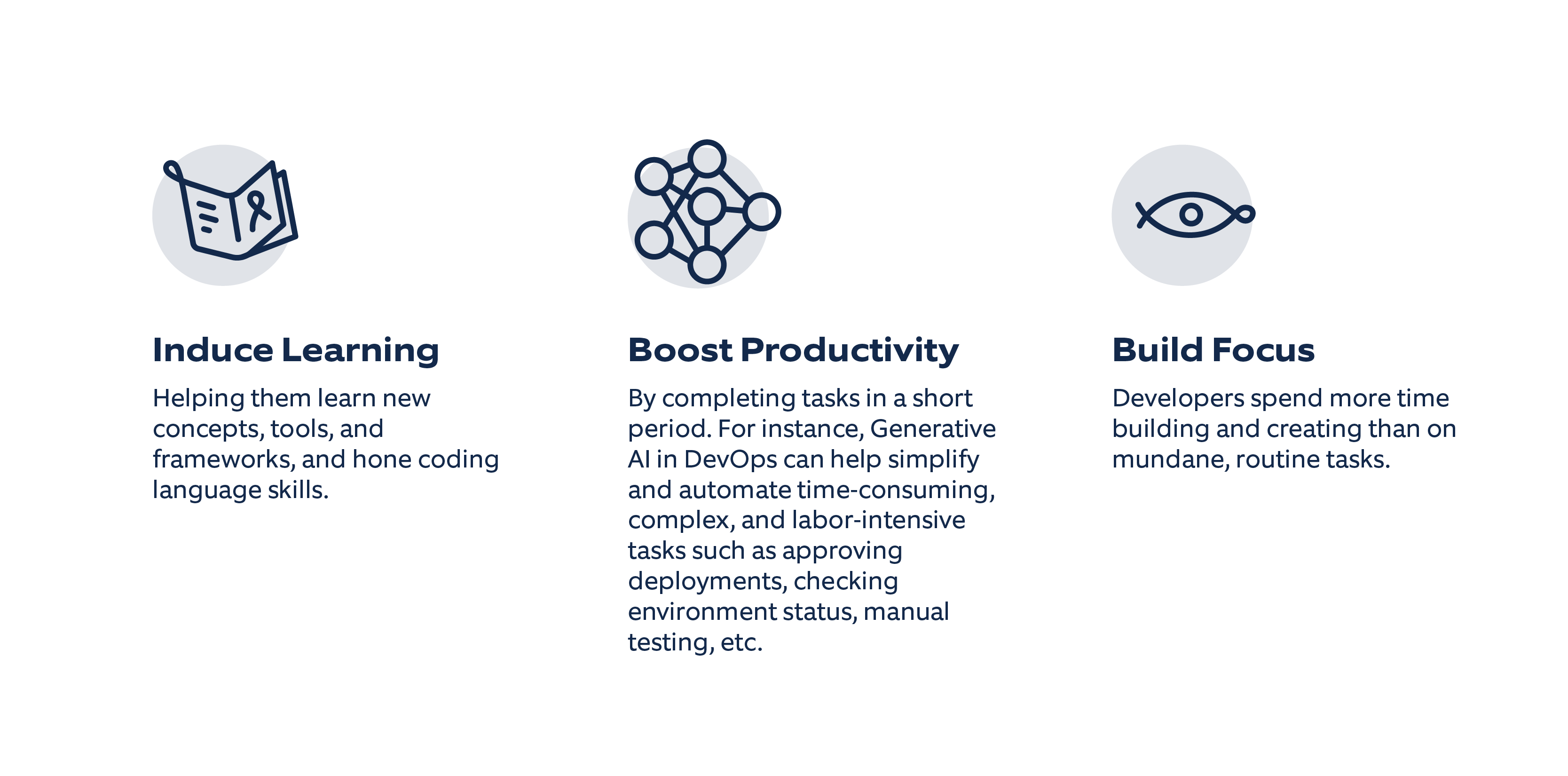 With its diverse applications, we can see Generative AI enhancing software development in several key areas.
With its diverse applications, we can see Generative AI enhancing software development in several key areas.- Code Generation, Improvement, and Debugging
- Software Testing and Quality Assurance
- Documentation
- UI/UX Design
Let’s discuss in detail:
1. Code Generation, Improvement, and Debugging
Generative AI automates code generation, saving time and effort for developers. By analyzing existing code, it generates efficient and functional code structures. Moreover, it aids in identifying and fixing errors, enhancing code quality, and reducing debugging time.
For instance, tools such as GitHub Copilot, CodeWhisperer, CodePal, etc., are helping software engineers generate code from a given prompt, improve an existing code, and even ease the migration of a large codebase from a legacy language like Cobol into modern languages like Java or C#, thereby drastically accelerating the code generation process and saving significant amount of manual effort.
Research by McKinsey & Company reports time savings of 35%-40% in code generation and 20-30% in code refactoring.
Our experts have hands-on experience with tools like GitHub Copilot, designed to assist developers in writing code more efficiently. The tool generates code suggestions, snippets, and entire functions after understanding context and code patterns, drastically accelerating the development process and maximizing developer productivity.
Case in point:
We recently partnered with a leading provider of an AI-enabled hiring platform to help them build a go-to-market solution with improved architecture. Given the strict timeline, we leveraged GitHub Copilot to write code faster and develop both frontend and backend features like APIs, connectors, business logic, etc. We deployed CoPilot in private mode and carried out 5-6 sprints code to train the model. It eventually started suggesting code, thereby driving ~15% reduction in sprint duration and saving cost & effort. Through this, we were able to develop a scalable and robust solution with advanced capabilities like an AI-powered ranking system, auto-proctoring, illegal content identification, etc., and ensured faster go-to-market for the client.
2. Software Testing and Quality Assurance
Did you know deployment of untested code is the most common production issue at 60% - as per a HackerRank Report?
Our teams have been researching how Generative AI can help improve testing by identifying bugs and errors in code, leading to better product quality.
It learns from existing requirement documents, defines and writes test cases as analysis, and identifies patterns and anomalies in the test results, thus simplifying post-execution analysis.
Moreover, it helps identify potential vulnerabilities, enabling developers to address security issues proactively. Tools such as DeepCode, MagnifAI, etc., are available to make it easier for software developers to test their applications and identify and fix issues while developers focus on other important tasks. Let’s take a quick look at how software testers are utilizing Generative AI:
- Analyze requirements: It is a complex task for software testers to read through several documents and analyze test requirements. Generative AI can simplify this process by learning from extensive documents and comprehending test requirements.
- Generate test cases: Generative AI helps generate a wide range of test cases, covering different input scenarios, boundary conditions, and edge cases, thereby significantly reducing the manual effort required to create test cases, especially for complex software systems.
- Detect bugs: Generative AI helps automatically detect and report software bugs. By analyzing code and execution traces, these models can identify potential issues, such as runtime errors, memory leaks, or logic flaws, helping testers focus their efforts on critical areas.
- Analyze test results: Generative AI tools can read and understand log files and test output data, and help transform it into actionable insights, identify failures, and highlight areas for improvement so you can improve software quality.
In line with these scenarios where Generative AI is transforming the role of software testers, Nagarro has developed an accelerator to automate the entire software testing process, from requirement gathering to building test cases, test steps, and test scripts.
Here’s how it works:
Once connected to a ticketing system, the accelerator captures user stories and provides recommendations to improve/update them. In the next steps, the tool can generate tests for all possible test cases, write test steps for each case and generate test scripts in the preferred language and framework such as TypeScript Playwright, Java Selenium Junit, etc. The tool also has a conversational interface that enables teams to edit/add/update test cases, ask questions, analyze test results, and get recommendations.
3. Documentation
Generative AI tools are also capable of writing technical documentation. They can generate user manuals and dynamically create user guides with contextual information, thereby making it easier to:
Share product information across teams, promote knowledge-sharing for reduced silos, and save manual efforts for development teams.
Generative AI-powered chatbots can also be integrated into the documentation platform to answer user queries instantly. Developers can ask questions about usage or troubleshooting, and the chatbot can generate responses based on the documentation content.
Additionally, with intelligent search, it helps carry out semantic search from structured (tables) and unstructured data (images, videos) through data connectors like SharePoint and SDFC.
In another example, Generative AI’s impressive command of natural-language processing helps engineers analyze documents and retrieve relevant information without wasting valuable time searching through pages of text.
It can also summarize extensive texts to a specific character limit, helping engineers save significant time and effort.
4. UI/UX Design
One of the key areas where Generative AI can help is its multi-modal capabilities that can convert text into images. Design specialists can use this feature to build user interfaces and customer journeys, accelerating the design process and allowing faster time to market.
For example, a designer uses an off-the-shelf solution like Adobe Firefly to generate images and edit them by giving the right prompts and defining the color scheme, layout preferences, branding guidelines, etc.
The evolving role of software developers
A recent study by McKinsey & Company highlights that developers who leverage Generative AI-based tools to perform complex tasks were 25%-30% more likely to complete them in the given time frame than those without the tools.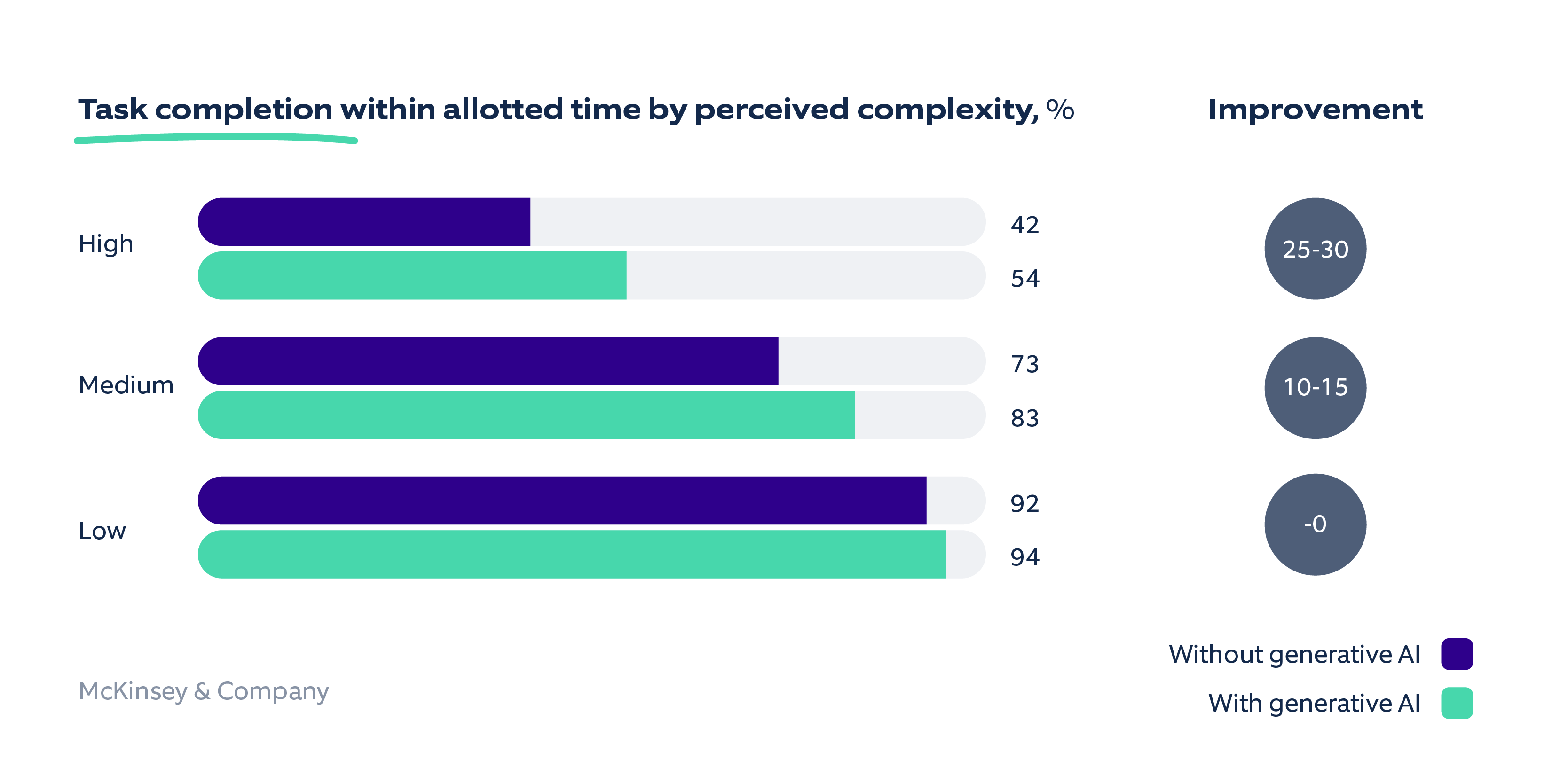
As Generative AI becomes an integral part of software development, we can see how the role of developers is evolving. So, how should developers utilize Generative AI efficiently to increase productivity? They must acquire expertise in working with AI algorithms, understanding machine learning techniques, and handling large datasets. Developers will collaborate with AI algorithms to create more efficient solutions, embracing new technologies and a fresh mindset. So, how should developers consume Generative AI efficiently to increase productivity? By mastering the art of prompt engineering!
Common use cases of prompt engineering
Large language models (LLMs) and other generative foundation models require contextual, specific, and tailored natural language instructions to generate the desired output. That means developers must write clear, concise, and informative prompts. The prompt's quality and detail determine the output's quality and relevance. Here’s how you can apply prompt engineering to harness the full potential of Generative AI:
- Clarity and Specificity: Prompts should be clear and specific about what you want from the AI model. Vague or ambiguous prompts can lead to unpredictable or incorrect responses. For example, using an ‘Image prompt’ to make the desired image. A prompt such as ‘icecreamcone.js > draw - draw an ice cream cone using p5.js’ would generate an irrelevant outcome. But adjusting it to be more specific, like ‘icecreamcone.js > Draw an ice cream cone with a scoop and chocolate on top; draw the ice cream cone with a triangle with the point facing down and be brown. The chocolate on top will melt, and the image background will be pink‘.
- Format and Structure: The format and structure of the prompt can influence the output. For example, if you want a model to generate a summary, you might structure the prompt like "Please summarize the following text: [input text]."
- Examples and Context: Providing examples or context in the prompt can help the model understand what you're looking for. For instance, you might say, "Generate a story about [character] who [scenario]."
- Length and Detail: The prompt's length and level of detail can impact the model's response. Sometimes shorter prompts work better, while other times, a more detailed prompt is necessary.
- Prompt Tuning: This involves iteratively refining prompts based on the model's responses. If the model isn't generating the desired output, you can experiment with different prompts until you achieve the desired result. Like this is a vague prompt, ‘# Write some code for grades.py’. Tuning it to ‘Implement the function calculate_average_grade in grades.py that takes a list of grades as input and returns the average grade as a floating-point number’ will help get specific results.
- Ethical Considerations: When engineering prompts, it's essential to consider ethical considerations. Avoid prompts that promote harmful or biased content, and ensure your prompts adhere to ethical guidelines.
- Testing and Validation: Before relying on AI-generated content, testing and validating the responses is crucial to ensure they are accurate and meet your requirements.
Areas for software developers to focus on in the era of Generative AI
Now, as we see Generative AI tools taking over the repetitive, time-consuming tasks, the technology is freeing up developers’ and engineers’ time to focus on innovation and solving complex problems that require human creativity and expertise while driving faster product releases.
Let’s explore the areas where developers can focus as they embrace Generative AI as their companion:
- Complex problem-solving: Software development is not only about writing code. So, while Generative AI takes over the mundane tasks, developers must focus on conceptualizing, architecting, and designing complex software solutions that meet specific requirements.
- Innovation and creativity: Technology lacks human creativity and intuition. This is why developers can leverage their creativity and focus on designing user interfaces, creating unique user experiences, and developing novel algorithms.
- ResponsibleAI: Software engineers play a pivotal role in ensuring ethical practices are followed throughout the software development.
- Building system resilience: As software developers are no longer confined to writing codes, they must go a notch up and help clients build system resiliency so they don’t have to stay up at night in case of any unforeseen events.
Generative AI Application Landscape for Engineers
As Generative AI revolutionizes software companies, there are a plethora of tools that have emerged for code generation, documentation, and other areas:
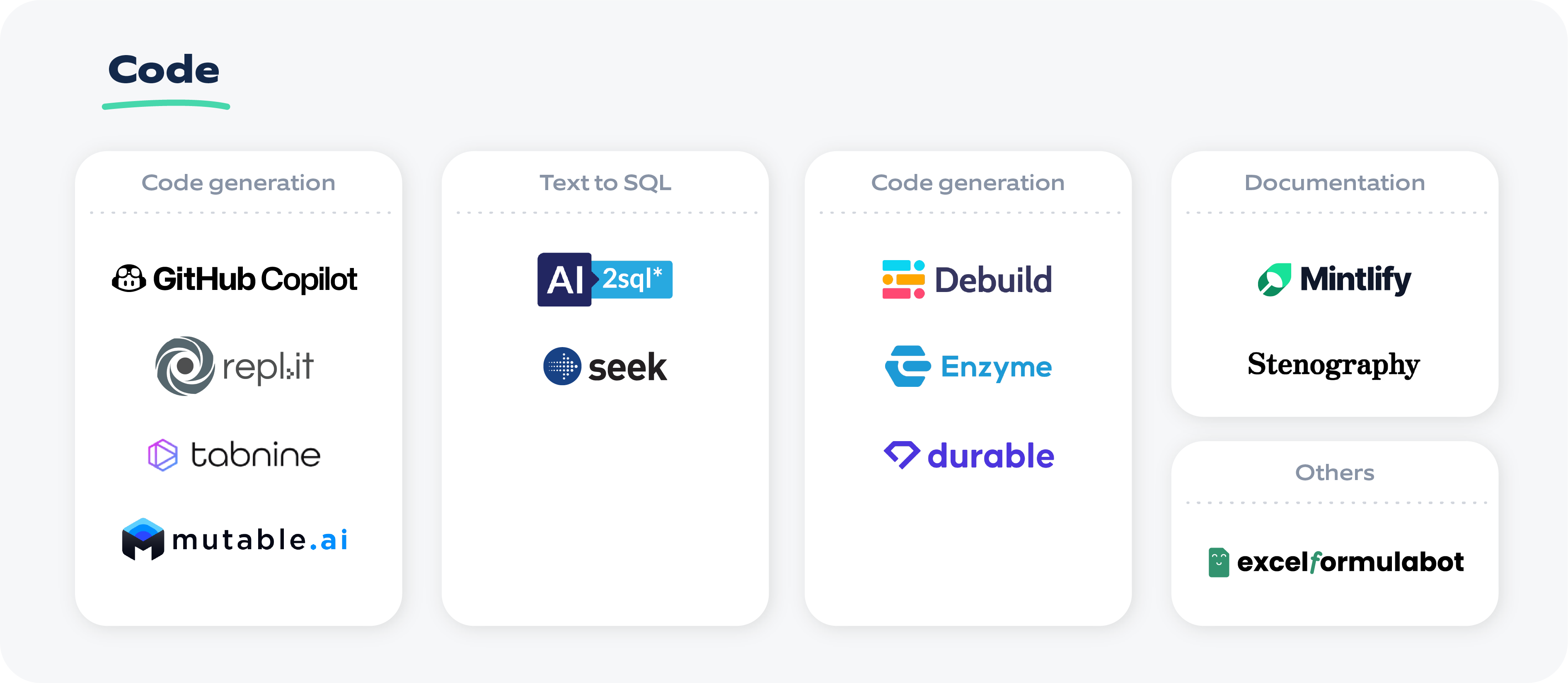
Top 10 use cases of Generative AI and our expertise
As a passionate and forward-thinking supporter of AI, we are here to enable your organization to harness the power of Generative AI and revolutionize software development and maintenance. With our extensive domain expertise and technology know-how, we can lead your organization through every step, from developing a robust strategy and selecting the right platform to successful implementation.
Explore these Nagarro built Generative AI tools and accelerators: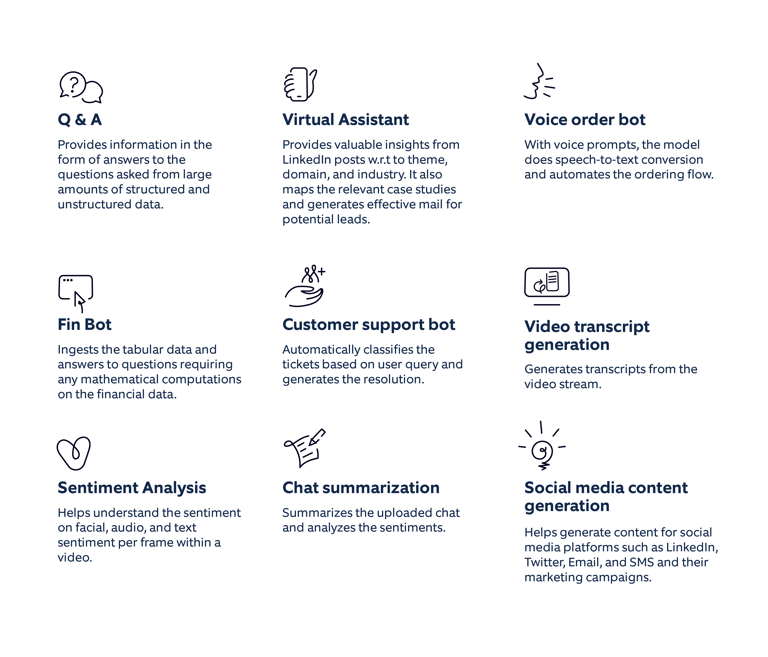
‘Intelligent Search’ as a service intends to help developers simplify the process of generating information using intelligent search to save time, effort, and resources.
Below is an example of how it helps improve developer productivity:
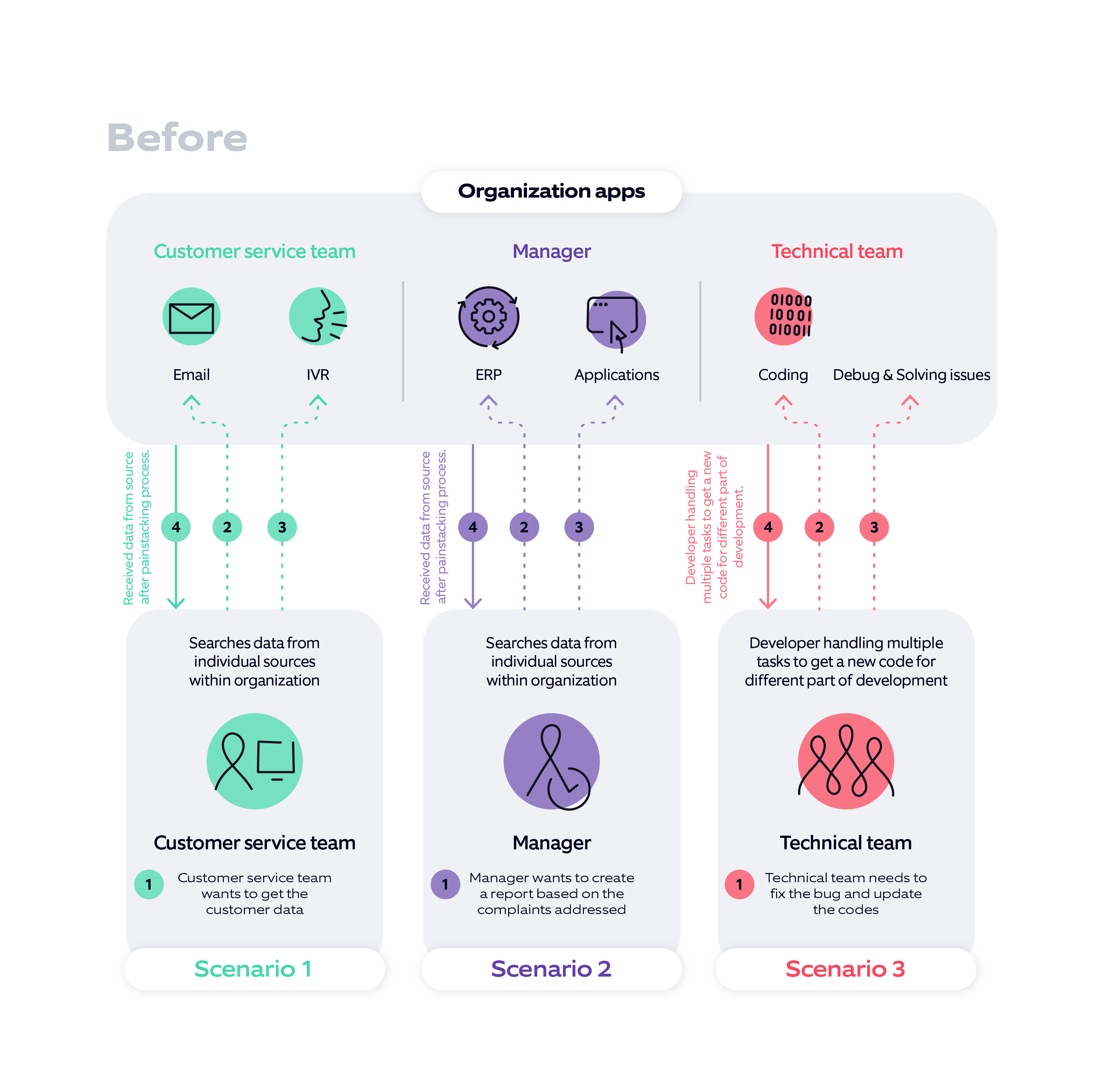
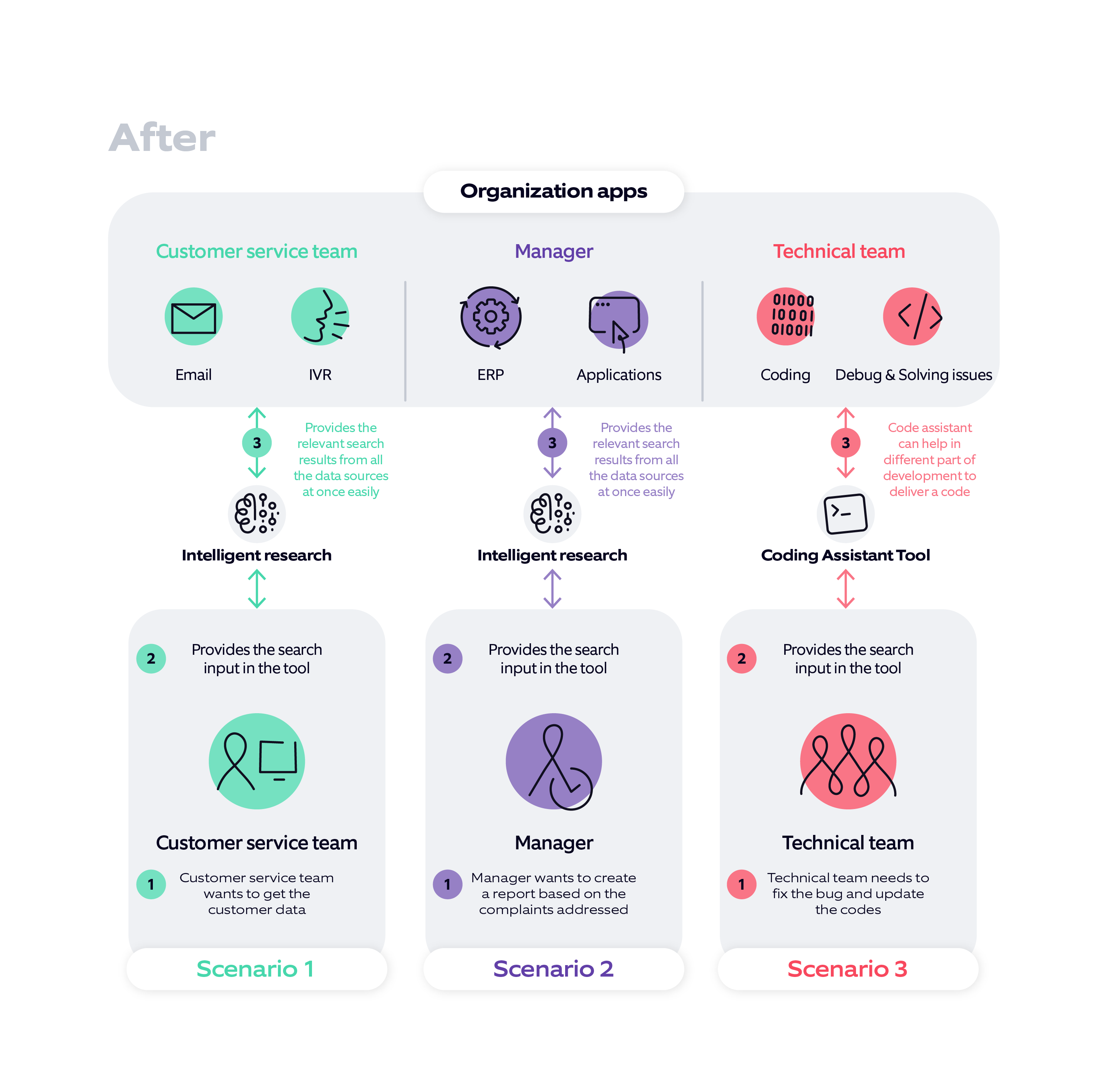
Let’s connect!
Like many others, are you too confused about how Generative AI can be leveraged in your product delivery?
We can help! Get in touch with us today!
References:






